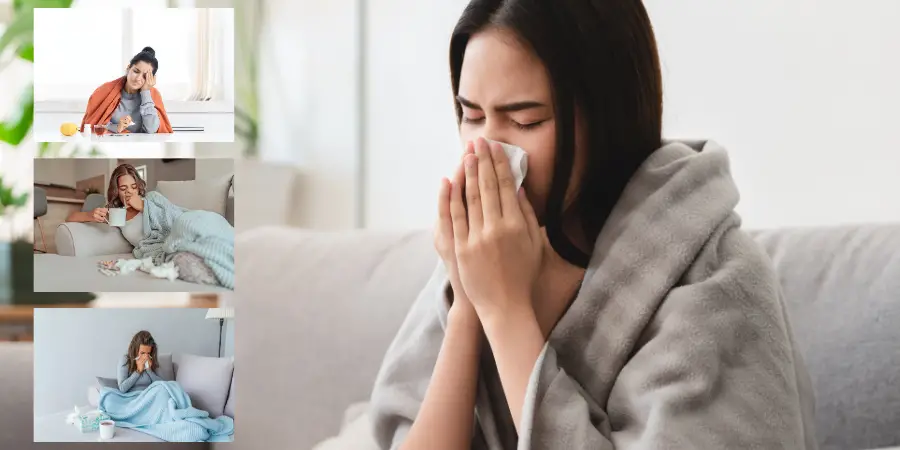Flu-like symptoms after massage – a peculiar phenomenon that often catches individuals off guard, leaving them perplexed and searching for answers. Did you know that a staggering 30% of massage recipients experience these unexpected symptoms? Yes, you heard that right! After indulging in a blissful session of rejuvenation, the last thing anyone anticipates is feeling under the weather. The prevalence of flu-like symptoms after massage has become a topic of intrigue among both massage enthusiasts and skeptics alike. Don’t worry, though; you’re not alone in this bewildering encounter.
Join us as we delve into the curious realm of post-massage reactions, uncovering the science behind these mysterious bodily responses. By the end, you’ll be armed with valuable insights to put your mind at ease, reassuring you that there’s more to this tale than meets the eye.
So, tighten your seatbelts, brace yourself, and let’s embark on a journey to demystify the enigmatic occurrence of flu-like symptoms after massage!
Common Flu-like Symptoms after a Massage

- Fatigue: Feeling unusually tired or exhausted after a massage is not uncommon. Your body may enter a relaxed state, leading to a temporary dip in energy levels.
- Muscle Soreness: Similar to post-workout soreness, some people may experience muscle aches or stiffness after a massage session. This can be a sign that your muscles are responding to the manipulation and releasing built-up tension.
- Headache: In certain cases, individuals may develop a mild headache after a massage. This could be due to the release of toxins, changes in blood flow, or tension being released from the neck and shoulders.
MUST READ: 5 Secret Reasons for Headache after Massage and their Cure - Nausea: Feeling queasy or experiencing an upset stomach after a massage can occur in some individuals. This reaction may stem from the stimulation of the parasympathetic nervous system, triggering digestion and potentially causing temporary discomfort.
- Mild Fever: Occasionally, a slight increase in body temperature, akin to a low-grade fever, may be observed after a massage. This can be attributed to the body’s response to the release of toxins or increased circulation.
Remember, these symptoms are generally temporary and should subside within a day or two. It’s important to communicate any concerns or unusual reactions with your massage therapist, who can provide insights and recommendations tailored to your specific needs. So, if you ever find yourself encountering these flu-like symptoms after a massage, fret not—your body is simply adjusting and embracing the revitalizing effects of this therapeutic practice.
While flu-like symptoms after a massage are generally uncommon, it’s important to acknowledge that individuals may experience a range of reactions. Here is a comprehensive list of potential flu-like symptoms that some people might encounter after a massage:
- Dizziness or lightheadedness
- Increased body temperature or mild fever
- Chills or feeling cold
- Sweating or excessive perspiration
- Runny or stuffy nose
- Sore throat or scratchy throat sensation
- Coughing or mild respiratory irritation
- Mild body aches or joint discomfort
- Fluctuations in appetite, such as increased or decreased hunger
- Restlessness or difficulty sleeping
- Feeling emotionally sensitive or teary-eyed
It’s essential to note that not everyone will experience all of these symptoms, and the severity and duration can vary. These reactions are typically temporary and should subside within a day or two as your body readjusts and responds to the massage therapy.
People Also Read:
- 7 Scientific Reasons Why Massage Feels So Good
- 5 Best Foods to Eat Before a Massage for Ultimate Relaxation (Veg & ; Non Veg)
- 5 Incredible Reasons to Try a Coconut Oil Massage Before Bath
What can cause flu-like symptoms after massage?
- Increased Blood Circulation: Massage techniques stimulate blood flow, which can lead to the release of toxins and waste products into the bloodstream. This detoxification process can trigger flu-like symptoms as the body eliminates these substances.
- Release of Toxins: Deep tissue massage or vigorous techniques can release accumulated toxins from muscle tissues. As these toxins enter the bloodstream, they can cause temporary flu-like symptoms as the body detoxifies.
- Inflammatory Response: Intense or prolonged pressure during a massage can induce a temporary inflammatory response in the body. This immune system reaction can manifest as flu-like symptoms, such as mild fever, body aches, or fatigue.
- Increased Metabolic Activity: Massage therapy can stimulate metabolic processes in the body, leading to an increased metabolic rate. This heightened activity can result in flu-like symptoms as the body works to restore balance and eliminate metabolic byproducts.
- Stimulation of the Lymphatic System: Massage techniques that target the lymphatic system, such as lymphatic drainage massage, can facilitate the removal of excess fluids and waste materials. This enhanced lymphatic activity can trigger temporary flu-like symptoms as the body clears toxins.
- Emotional Release: Massage therapy can evoke emotional responses and facilitate the release of pent-up emotions and stress. Emotional releases can sometimes manifest as flu-like symptoms, including fatigue, headache, or emotional sensitivity.
- Individual Sensitivity: Each person’s body reacts differently to massage, and some individuals may be more sensitive or susceptible to experiencing flu-like symptoms. Factors such as underlying health conditions, stress levels, or overall well-being can influence individual reactions.
- Temperature Changes: Exposure to different temperatures during a massage, including changes in room temperature or being undressed, can affect the body’s temperature regulation. Fluctuations in body temperature can contribute to flu-like symptoms such as chills or feeling warm.
- Hydration Levels: Massage therapy can enhance circulation and fluid movement in the body. It is important to maintain proper hydration before and after a massage, as dehydration or inadequate fluid intake can exacerbate flu-like symptoms.
- Preexisting Health Conditions: Individuals with certain health conditions, such as chronic fatigue syndrome, fibromyalgia, or autoimmune disorders, may be more prone to experiencing flu-like symptoms after a massage due to their underlying conditions.
Remember, while flu-like symptoms after a massage can be discomforting, they are usually temporary and part of the body’s natural response to the therapy. If you have concerns or the symptoms persist or worsen, it is advisable to consult with a healthcare professional to rule out any underlying conditions and obtain personalized advice.
11. One very interesting reason
Another factor that can contribute to flu-like symptoms after a massage is the exposure of the body without clothes during the massage. This exposure can lead to changes in body temperature regulation, potentially triggering symptoms resembling those of the flu.
When you remove your clothes for a massage, your body loses its typical insulation, leaving it more susceptible to temperature variations. The massage room may be set at a comfortable temperature, but your body’s natural thermoregulation mechanisms can still be affected. As a result, you may experience fluctuations in body temperature, feeling either slightly warmer or cooler than usual.
These temperature shifts can influence the body’s overall functioning and contribute to flu-like symptoms. It’s not uncommon for people to experience chills, mild fever, or fluctuations in body heat distribution during or after a massage. These symptoms are often temporary and resolve as your body adjusts to its normal temperature regulation.
To ensure your comfort during a massage, therapists typically provide blankets or adjust the room temperature according to your needs. Communicating any discomfort or sensitivity to temperature changes with your therapist can help create a more enjoyable and tailored experience.
Read if you are a female:
- Unlock the Secret to Better Milk Flow: Breast Massage While Pumping Explained
- Powerful Foot Massage During Pregnancy: Benefits, Risks, and Precautions
- Experience the Magic of Coconut Oil Massage for PCOS Relief
How to avoid flu-like symptoms after massage?
Here’s a concise list of ways to potentially avoid flu-like symptoms after a massage:
- Stay hydrated.
- Communicate with your massage therapist.
- Gradually increase massage intensity.
- Relax and rest.
- Practice self-care.
- Maintain a healthy lifestyle.
These tips can help minimize the likelihood or intensity of flu-like symptoms after a massage.
Here are some additional ways to potentially avoid flu-like symptoms after a massage and minimize their impact:
- Support Your Immune System: Prioritize your immune health to minimize the chances of experiencing flu-like symptoms after a massage. Incorporate immune-boosting foods and consider supplements or herbs known for their immune-supportive properties, under the guidance of a healthcare professional.
- Avoid Alcohol and Caffeine: Limit your consumption of alcohol and caffeine, as they can dehydrate the body and potentially intensify post-massage symptoms resembling the flu.
- Schedule Adequate Recovery Time: Allow yourself sufficient recovery time after a massage to reduce the likelihood of experiencing flu-like symptoms. Avoid over-scheduling or engaging in intense activities immediately after your session, allowing your body to fully relax and benefit from the therapy.
- Consider Detoxification Support: Support your body’s natural detoxification process by incorporating detoxifying practices. This can include dry brushing before your massage, indulging in warm Epsom salt baths, or utilizing herbal teas or supplements known for their detoxifying properties.
- Follow Up with Gentle Movement: Engage in gentle movement or stretching exercises in the days following your massage, which can help promote circulation, reduce muscle soreness, and aid in the elimination of toxins that may contribute to flu-like symptoms.
- Listen to Your Body: Pay close attention to how your body responds to different massage techniques. If certain areas feel excessively tender or sensitive, communicate with your massage therapist to adjust the pressure or focus on alternative areas to minimize the likelihood of experiencing flu-like symptoms after the massage.
Remember, these additional suggestions can complement your overall massage experience and potentially reduce the chances of experiencing flu-like symptoms resembling those that occur after a massage. It’s important to find what works best for you and consult with a healthcare professional for personalized advice based on your specific circumstances.
Warning! (Case Study)
The research tells the story of a 39-year-old man who got a deep tissue massage and then developed severe muscle damage, kidney problems, and flu-like symptoms. The researchers found a possible link between the massage and the worsening of these symptoms caused by an influenza A infection. They believe that the flu virus might invade the muscles directly, leading to injury. The study also suggests that the massage may have increased the virus’s ability to affect the muscles. This case highlights the importance of monitoring and managing muscle-related complications in severe cases of the flu after getting a massage
Does it mean my flu-like symptoms after a massage are dangerous?
The research paper discussed a unique case where a deep tissue massage appeared to exacerbate flu-like symptoms in a person with an influenza A infection, leading to severe muscle damage and kidney problems. While this case highlights a rare occurrence, it’s important to note that flu-like symptoms after a massage are typically not dangerous and are considered a normal response by the body. Most individuals experience mild symptoms such as muscle soreness, fatigue, or slight discomfort, which resolve on their own within a few days. However, if you have concerns about your specific symptoms or underlying health conditions, it is always advisable to consult with a healthcare professional for personalized guidance and evaluation.

